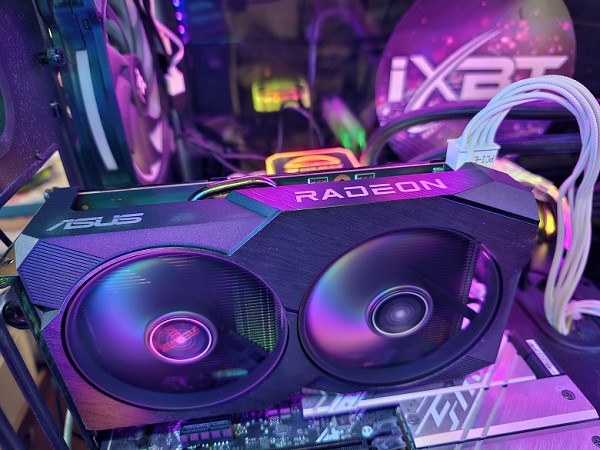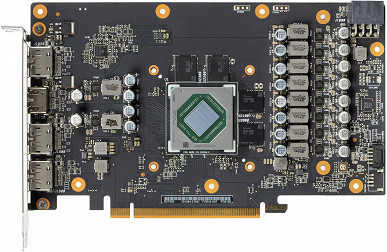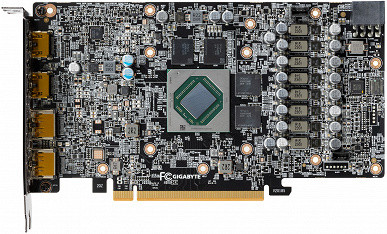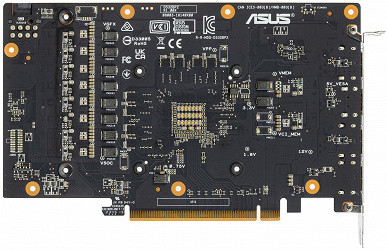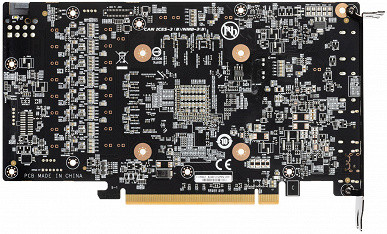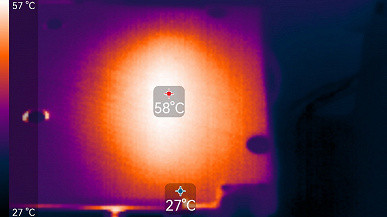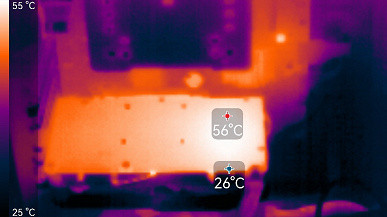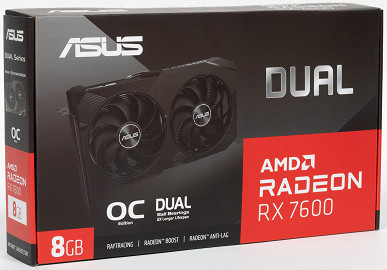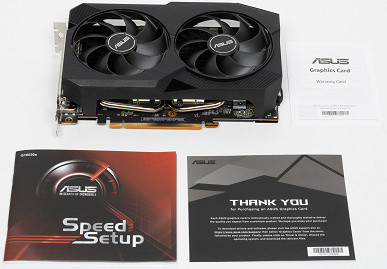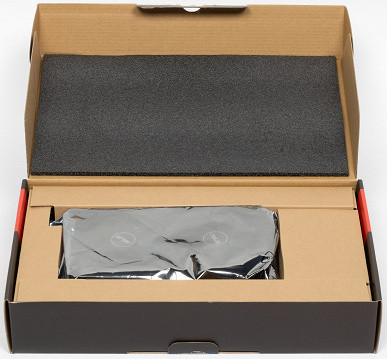Briefly about the main thing
Today we continue our examination of the latest generation of mass-produced graphics cards. Our focus is on the Radeon RX 7600, the youngest model from AMD in the current gaming segment. We will also take a look at the Dual series from Asus, which is rare in our lab.
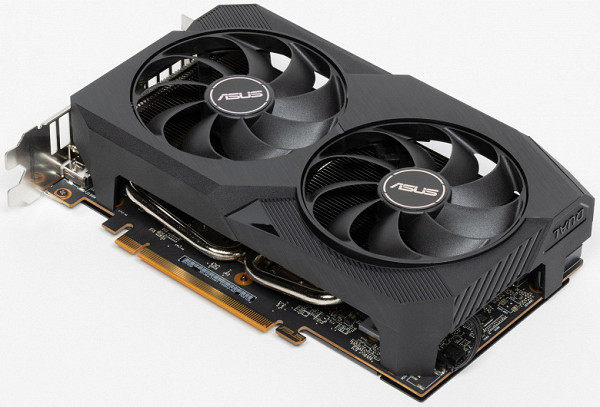
This series of graphics cards is well known, but it represents a younger and more simplified model from the manufacturer. While the Asus brand is often associated with high-end gaming lines, this series has long been a rarity in our market. The appearance of the card confirms its modesty.
Before moving on to detailed tests, we will provide brief information on the performance of the family to which the accelerator in question belongs, as well as its competitors. This data will be assessed subjectively at seven levels.
Games without ray tracing (classic rasterization):
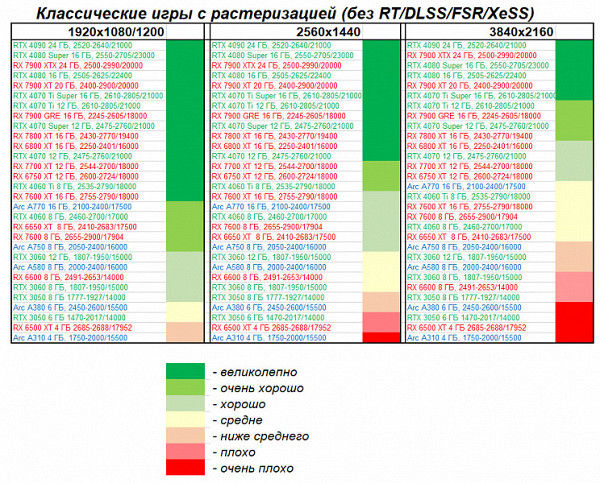
The Radeon RX 7600's performance is between the GeForce RTX 4060 and GeForce RTX 3060, roughly on par with the Radeon RX 6650 XT, and slightly better than the Arc A750. This card offers excellent gameplay at maximum settings at 1080p with ray tracing and scaling disabled. At 2.5K, the FPS remains acceptable, although you may need to lower the graphics settings in some cases to play comfortably. 4K is too demanding for this card, except for simple, graphically uncomplicated games (such as online games).
The Asus card slightly outperforms the reference version thanks to the factory GPU clock rates.
Games using ray tracing and DLSS/FSR/XeSS:
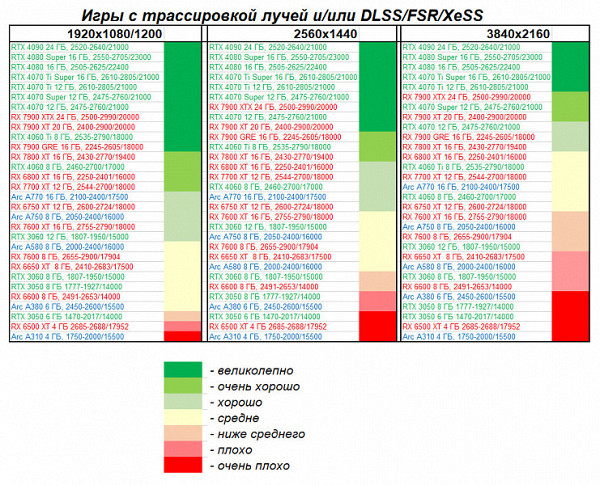
In games with ray tracing and dynamic scaling, the Radeon RX 7600 lags slightly behind the GeForce RTX 3060, reaching the level of the Arc A750, while the GeForce RTX 4060 significantly surpasses it. This accelerator from AMD can handle such games only at a resolution of 1080p (Full HD), and to achieve maximum graphics quality, you will need to enable FSR or XeSS technologies.
Card characteristics
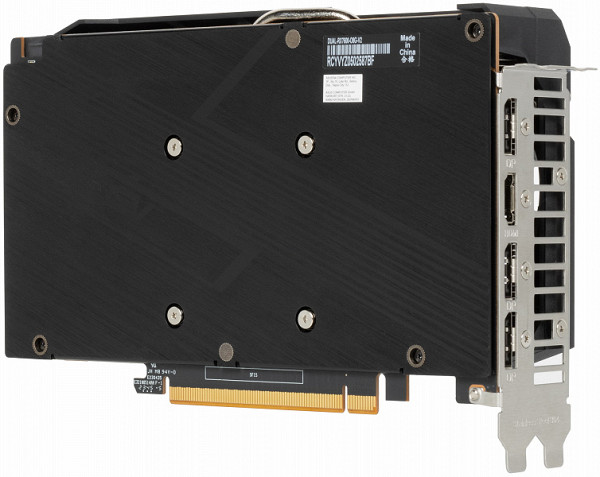
Asustek Computer, better known under the Asus brand, was founded in 1989 in Taiwan. The headquarters are located in Taipei. It has been present on the Russian market since 1992 and is one of the oldest manufacturers of video cards and motherboards. Currently, Asus produces a wide range of products in various segments of the IT industry, including mobile devices. The company's production facilities are located in China and Taiwan, and the total number of employees is about 2,000 people.
| Asus Dual Radeon RX 7600 OC 8GB 128-bit GDDR6X | ||
|---|---|---|
| Parameter | Meaning | Nominal value (reference) |
| GPU | Radeon RX 7600 (Navi33) | |
| Interface | PCI Express x8 4.0 | |
| GPU Operating Frequency (ROPs), MHz | 2725(Boost)—2863(Max) | 2655(Boost)—2900(Max) |
| Memory frequency (physical (effective)), MHz | 2238 (17904) | 2238 (17904) |
| Memory bus width, bit | 128 | |
| Number of computing units in a GPU | 32 | |
| Number of operations (ALU/CUDA) in a block | 64 | |
| Total number of ALU/CUDA blocks | 2048 | |
| Number of texture units (BLF/TLF/ANIS) | 128 | |
| Number of rasterization units (ROP) | 64 | |
| Number of Ray Tracing Blocks | 32 | |
| Number of tensor blocks | — | |
| Dimensions, mm | 245×135×50 | 205×115×40 |
| The number of slots in the system unit occupied by the video card | 3 | 2 |
| Color of PCB | black | black |
| Peak power consumption in 3D, W | 169 | 168 |
| Power consumption in 2D mode, W | 22 | 22 |
| Power consumption in sleep mode, W | 4 | 4 |
| Noise level in 3D (maximum load), dBA | 24.2 | 35.0 |
| Noise level in 2D (video viewing), dBA | 18.0 | 18.0 |
| Noise level in 2D (idle), dBA | 18.0 | 18.0 |
| Video outputs | 1×HDMI 2.1, 3×DisplayPort 2.1 | 1×HDMI 2.1, 3×DisplayPort 2.1 |
| Support for multiprocessor operation | No | |
| Maximum number of receivers/monitors for simultaneous image output | 4 | 4 |
| Power: 8-pin connectors | 1 | 1 |
| Power: 6-pin connectors | 0 | 0 |
| Power: 16-pin connectors | 0 | 0 |
| Weight of the card with the delivery set (gross), kg | 1.05 | 1,1 |
| Net weight of the card, kg | 0.63 | 0.76 |
| Max Resolution/Frequency, DisplayPort | 3840×2160@144 Hz, 7680×4320@60 Hz | |
| Maximum Resolution/Frequency, HDMI | 3840×2160@144 Hz, 7680×4320@60 Hz |
Memory
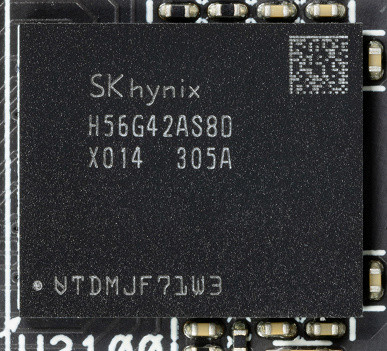
The card is equipped with 8 GB of GDDR6 SDRAM, located in four 16 Gb chips on the front side of the printed circuit board (PCB). The SKhynix memory chips (model H56G42AS8DX014) have a nominal operating frequency of 2500 MHz (effective 20000 MHz).
Features of the card and comparison with Gigabyte Radeon RX 7600 Gaming OC (8GB)
We compare this card with a similar model from another manufacturer, since we do not have a reference card from AMD, and the first card in the lab was a card from Gigabyte based on the Radeon RX 7600. We noticed that the printed circuit boards (PCB) are similar in layout, but Asus has a significantly simplified board and is specially adapted for the Radeon RX 7600, while Gigabyte used almost the same board as for the Radeon RX 6600 XT / 6650 XT.
The core has an encrypted digital marking, the release date is the 42nd week of 2022.
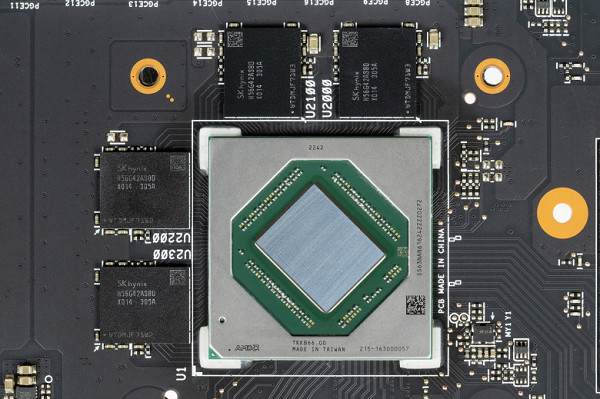
The total number of power phases in the Asus card is 10 (8+2).
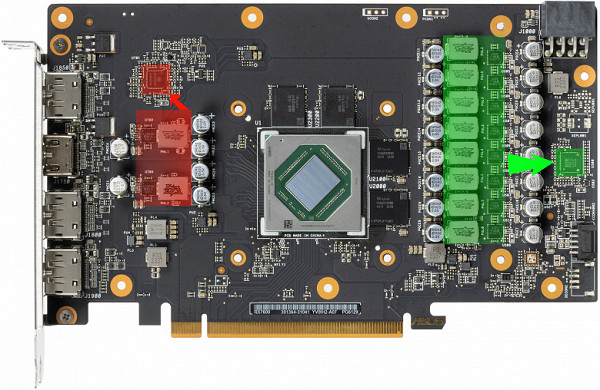
The power supply diagram of the core is marked in green, and the memory is marked in red. All PWM controllers are located on the front side of the PCB.
The power supply of the core is controlled by the PWM controller IR35217 (Infineon), which supports up to 8 power phases.
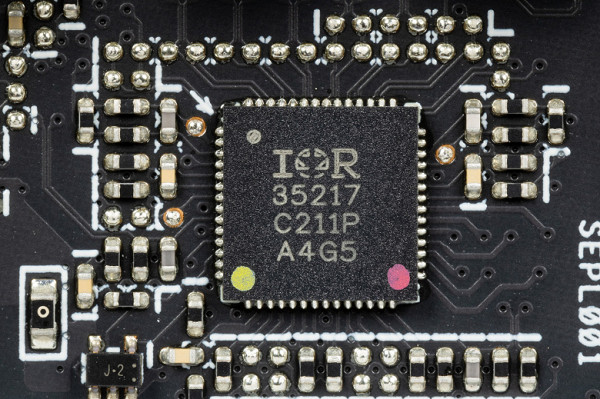
The power supply of the memory chips is controlled by the NCP81022 PWM controller (On Semiconductor).
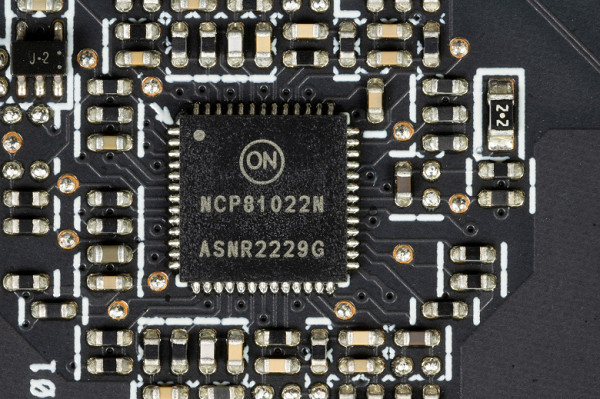
The core power converter uses DrMOS transistor assemblies — in this case, Vishay SiC654A (50A).
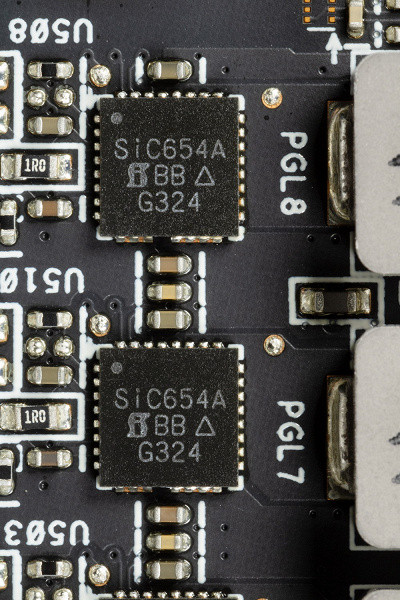
There is no separate controller for monitoring voltages and temperatures, as these functions are performed by the GPU itself.
The card has no backlight, so there is no controller for it either.
The memory frequencies correspond to the reference values. However, the Boost core frequency of the Asus is increased by 2.6% compared to the reference, although the maximum frequencies are slightly lower than those of the reference card. This led to an increase in performance by an average of 2%.
The power consumption of the Asus card in tests reached 169 W.
The card is powered via a standard 8-pin PCIe 2.0 connector.

The overall dimensions of this card are small, but the thickness is 5 cm, so the video card does not fit into 2 slots in terms of thickness.

The card's operation is controlled using the proprietary Asus utility.
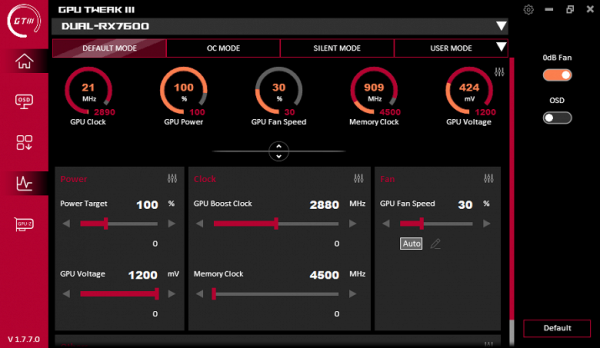
Preset frequency mode by default
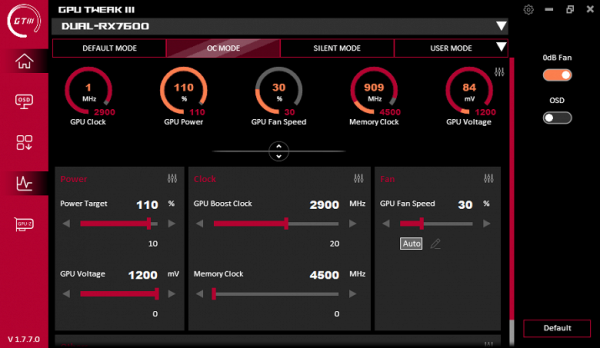
Preset OC Mode (core frequency is 20 MHz higher)
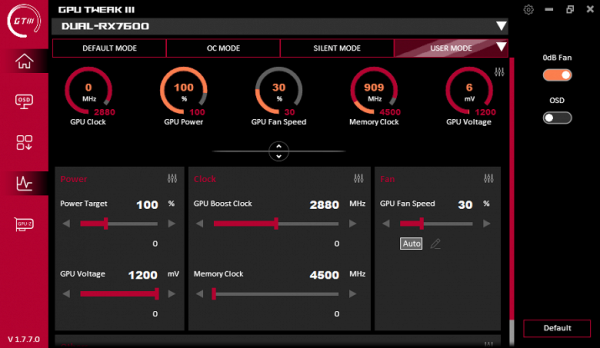
Manual adjustment of the card operation by frequencies, limits and voltages
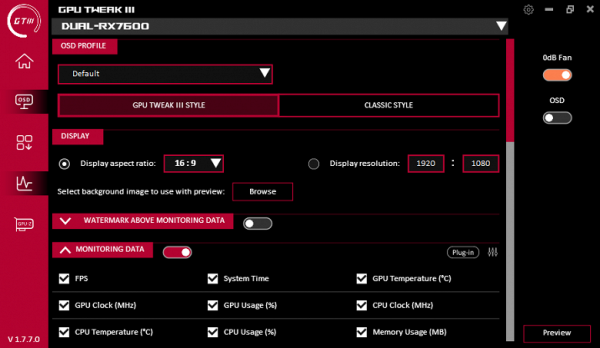
Setting up OSD operation
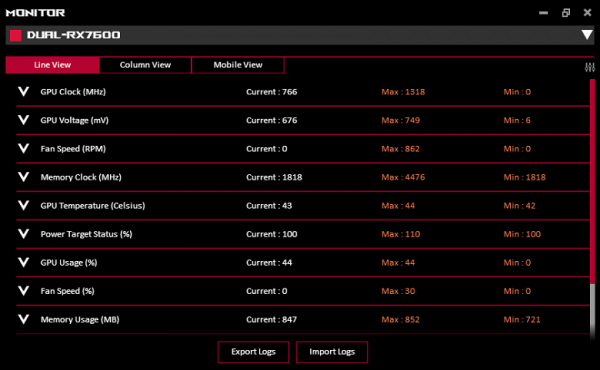
Dashboard
Heating and cooling
The basis of the cooling system is a relatively small nickel-plated plate radiator with heat pipes soldered to a large heat-sink plate.
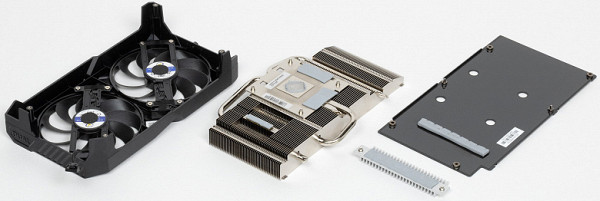
The same radiator also serves as a cooler for memory chips via a thermal interface. The components of the VRM power converters are also cooled (via additional mini-radiators).

The back plate is made of aluminum with an insulating coating. It serves not only to protect the PCB, but also helps cool the components in the area of the VRM power converters via the thermal interface.
The radiator has a shroud with two 100 mm Axial-tech fans. The ends of their blades are connected by a ring, which provides more efficient airflow to the radiator. Each fan is equipped with two ball bearings.
The fans stop at low load if the GPU temperature drops below 50 ° C, making the cooling system silent. When the PC starts, the fans work, but after the video driver loads, temperature monitoring begins and they turn off. Below is a video illustrating this process.
Temperature monitoring:
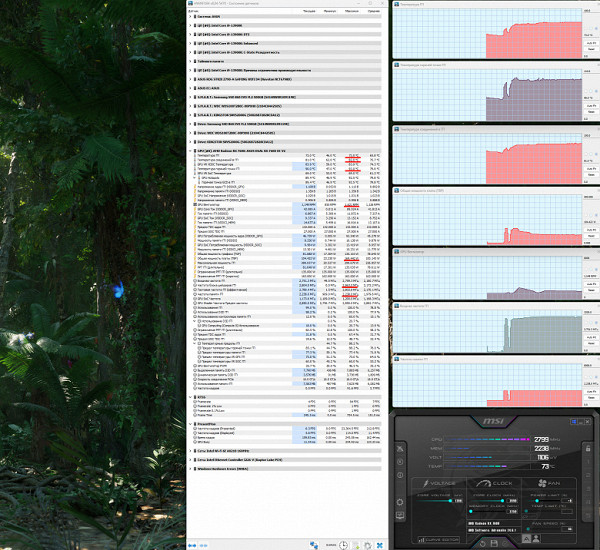
After two hours of operation under load, the maximum GPU temperature did not exceed 73°C, while the hot spot reached 93°C, and the memory chips — 84°C. These figures are considered satisfactory for video cards of this class. The card's power consumption reached 169 W. Let us remind you that the hot spot heating limit is 110°C, which is used by AMD drivers to determine the need to reduce the GPU operating frequencies.
We also recorded and sped up the eight-minute warm-up process by 50 times.
The maximum heating was observed in the VRM area, as well as near the power connector.
Noise
The noise measurement technique is carried out in a soundproof room with minimized reverberation. The system unit in which the video card noise is studied has no fans and does not emit mechanical sounds. The background noise level is 18 dBA, which takes into account both the noise in the room and the noise level of the noise meter itself. Measurements are taken at a distance of 50 cm from the video card at the level of the cooling system.
The measurements are taken in the following modes:
- 2D idle mode: an Internet browser with the iXBT.com website, a Microsoft Word window, and several Internet communicators are open.
- 2D mode with movie viewing: SmoothVideo Project (SVP) is used for hardware decoding and insertion of intermediate frames.
- 3D mode with maximum load: FurMark test.
Noise level gradations:
- Less than 20 dBA: relatively silent
- 20 to 25 dBA: very quiet
- 25 to 30 dBA: quiet
- 30 to 35 dBA: clearly audible
- 35 to 40 dBA: loud, but bearable
- Above 40 dBA: very loud
In idle mode in 2D, the temperature did not exceed 37 ° C, the fans did not work, the noise level corresponded to the background — 18 dBA.
When watching a movie with hardware decoding, the situation remained unchanged.
In maximum load mode in 3D, the temperature reached 73/93/84 ° C (core / hot spot / memory). The fans developed up to 1621 rpm, the noise level increased to 24.2 dBA, which corresponds to the level of «quiet, even very quiet».
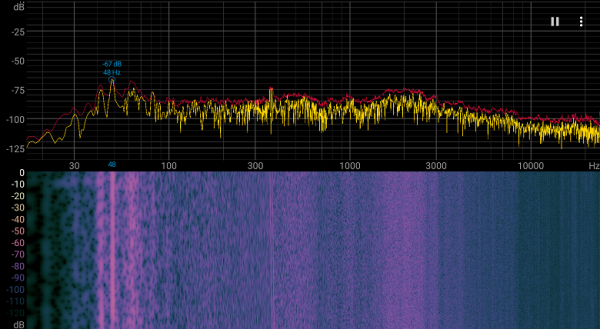
Backlight
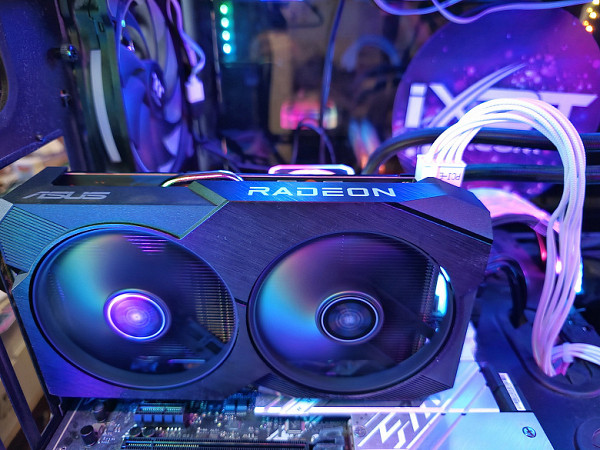
The map has no backlight.
Delivery set and packaging
In addition to the card itself, the delivery set only includes a quick user guide.
Conclusions
Asus Dual Radeon RX 7600 OC (8 GB) is a budget graphics card for undemanding gamers who prefer Full HD resolution and do not plan to use ray tracing. It is relatively compact (24x13 cm), but takes up three slots in the system unit and can consume up to 170 watts. Power is supplied via a standard 8-pin connector. Cooling is effective and quiet, but the card does not have a backlight.
The manufacturer provides a 3-year warranty for this model.
Radeon RX 7600 is based on the RDNA3 architecture and offers good comfort in games at maximum settings with ray tracing and scaling technologies disabled at 1080p. At 2.5K, FPS also remain acceptable, although some games may require lowering the graphics settings. When enabling ray tracing and using FSR / XeSS, it is recommended to limit yourself to Full HD resolution to maintain a high level of graphic quality.
It is important to note that the Radeon RX 7000 series graphics cards feature DisplayPort 2.1 UHBR13.5 connectors, which gives them an advantage over GeForce with DisplayPort 1.4a, allowing for 4K/240Hz output without streaming compression over a single cable. They also fully support AV1 encoding and decoding.
